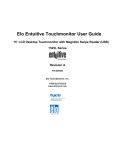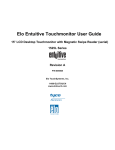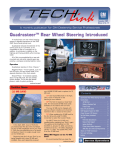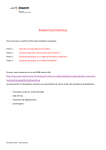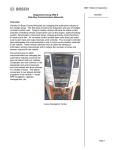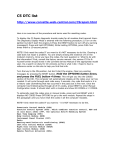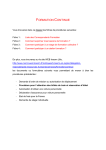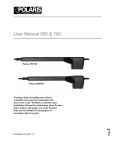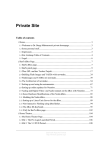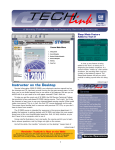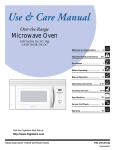Download Contents Reminder: How to Access GM Training Courses on the
Transcript
September 2001 Volume 3, No. 9 Some customers may inquire about replacing the factory radio with an aftermarket setup or with an uplevel factory unit. The days when a radio was a selfcontained box are long gone. The first major change was the use of the Delphi Entertainment and Comfort bus. Now, on some of the newest vehicles, the entertainment system is integrated into the vehicle’s serial data network. This means that the radio must be capable of communicating over the serial data bus (also called class 2) with various other modules in the vehicle. When a conventional radio is turned off, it is truly off. A radio unit in the serial data system, however, only looks “off” when it is turned off. Various circuits remain aware of what’s going on, and will wake up at a moment’s notice. For instance, the chimes and OnStar® both use the radio speakers, and will operate even if the radio function is turned off. In a serial data system, all modules check the state of health of all other modules, so removing one module will have a widespread effect on the entire network. See the accompanying sidebar for a list of 2002 vehicles that do not use the serial data bus. Using the 2002 Envoy as an example, here are some consequences of swapping the factory radio for an incompatible aftermarket unit. - Radio is inoperative. - “Hard” code set in diagnostics due to radio not being on the data bus - Loss of steering wheel mounted control functions - OnStar system will not work continued on page 2 Techline News Reminder: How to Access GM Training Courses on the Web In June, we told you about the new web-based SI 2000 training course just added to the Service Technical College catalog. Here’s how to get to the course. You need to log into the Training Management System (TMS) at www.gmcommontraining.com. If you have a past training history, you should be in the TMS, and can log in by using your Social Security Number as both your SSN and Password. If you are not in the TMS, or are having difficulties logging in, call the Common Training Help Desk at 888.748.2687. Once in the TMS, select the Catalog tab, then select Catalog Search. or Begins With, then type SI 2000. When the course information appears, select View. The next screen that appears contains the course description. At the top left of the screen, click on Take or Continue Course to access the SI 2000 web based training. See the June, 2001, issue of TechLink for a description of how the course works. Contents What Happens When a Radio is Swapped? . . . . .1 Techline News How to Access GM Training Courses on the Web . . . . . . . . . . . . . . . . . . . . . . . .1 Be sure to fill out the evaluation form at the end of the course to let GM know how you liked it. Technical Assistance Center Phone Prompt Changes . . . . . . . . . . . . . . . . . . . . .3 TIP: You need to have Flash 4 or newer to run the course. Here are the instructions for obtaining the proper version of Flash Player for the SI 2000 course. Fuel Injector Cleaning . . . . . . . . . . . . . . . . . . . .3 Demystifying Class 2 Diagnosis . . . . . . . . . . . . .4 The LATCH System . . . . . . . . . . . . . . . . . . . . . .6 Without GM Online Select Course Number, then select “Is”, then type 10040.00W. Click on the Submit button. 1. Install the GM STC CBT Browser v2.0. (CD is orange colored and labeled “Install Disk for CBT Training, version 2.0 March 2001”.) TIP: You can also do a course name search by selecting Course Name, Contains, 2. Or Visit www.macromedia.com/downloads and continued on page 2 1 Diagnosing 4T65E Transmission . . . . . . . . . . . . .7 Dealing with Police Special Equipment Options . . .7 Bulletins . . . . . . . . . . . . . . . . . . . . . . . . . . . . .8 Service Operations 2002 Vehicles Without Serial Data Bus Radio Tr ucks Silverado/Sierra Astro/Safari GMC-Series T-Series S10/Blazer/Sonoma Cars Park Avenue Camaro/Firebird Century/Regal/Grand Prix - Loss of rear audio -- The audio amplifier is standard on some vehicle lines, optional on most. The radio supplies low level audio signals to the audio amplifier in order to boost the signal sent to the speakers. The serial data circuit allows the radio to recognize that an amplifier is present. Once the radio detects an audio amplifier, it will output low level audio signals. The audio amplifier is turned on when it receives a message via the serial data circuit indicating that the radio is on. - Loss of built-in Theftlock audio component theft deterrence -- The aftermarket radio will not have the protection of the GM Theftlock feature. Theftlock is intended as a roadblock to switching radios from vehicle to vehicle, such as would occur in case of theft. Here’s how it works. The theft deterrent system utilizes serial data to determine if the radio is in the appropriate vehicle. Each time the radio receives the "run" power mode message, it compares the VIN information stored in the radio to the VIN information received from a module on the serial data circuit responsible for transmitting that information. If a mis-match occurs, the radio display will indicate to the user that the radio is locked. Once this takes place, a DTC will set, the radio will not respond to any button presses and will become inoperative. - Loss of chimes (important audible signals to the driver) - Loss of remote playback devices (if equipped) -- There are three types of remote playback devices: a multi disc remote CD changer, a single disc CD player and a cassette player. These devices may be factory installed, or in some cases, dealer installed. All three devices have a wiring harness which plugs into the back of the radio. The radio controls and communicates with the remote playback device through the data bus. Replacing the Standard Factory Unit with an Uplevel Factory Unit Harnesses and hardware are specific to each level of radio. Replacing a standard radio with a Bose® unit, for instance, involves far more than just inserting a new radio unit into the instrument panel. This is not recommended by GM. GM TechLink is a monthly magazine for all GM retail technicians and service consultants providing timely information to help increase knowledge about GM products and improve the performance of the service department. This magazine is a companion to the GM Edge publication. Publisher & Editor: Mark Stesney GM Service Operations /[email protected] Technical Editor: Jim Horner /[email protected] 1-248-816-3641 Production Manager: Marie Meredith Several dealer-installed plug-in remote playback modules are available, however. See the preceding section for details. Desktop Publishing: Radio Setup FAX number: When the radio is turned on, it expects to receive the appropriate VIN information on the serial data line. If this does not happen, the radio will lock up. A mismatch will occur under two circumstances: 1. A radio is installed from another vehicle (or a service replacement is installed). 2. The module which communicates on the serial data circuit which supplies VIN information to the radio is replaced and not properly set up with the correct VIN information for that vehicle. The only way to unlock the radio is by using a scan tool. Follow the procedures in SI 2000. – Thanks to Chris Edghill, Mark install the appropriate Flash Player to support their browser: a. Internet Explorer b. Internet Explorer for AOL c. Netscape Navigator With GM Online Obtain a local deviation from the GM Online site manager and request an upgrade to Flash Player 4.0 or 5.0. Greg Szpaichler, MediaWurks /[email protected] 3 1-248-649-5465 Write to: * TechLink PO Box 500 Troy, MI 48007-0500 GM TechLink on the Web: http://service.gm.com : General Motors service tips are intended for use by professional technicians, not a "do-it-yourselfer." They are written to inform those technicians of conditions that may occur on some vehicles, or to provide information that could assist in the proper service of a vehicle. Properly trained technicians have the equipment, tools, safety instructions and know-how to do a job properly and safely. If a condition is described, do not assume that the bulletin applies to your vehicle or that your vehicle will have that condition. See a General Motors dealer servicing your brand of General Motors vehicle for information on whether your vehicle may benefit from the information. Inclusion in this publication is not necessarily an endorsement of the individual or the company. Copyright© 2001 General Motors Corporation All rights reserved. – Thanks to Chris Wallace 2 Return to page 1 Technical Assistance Center Phone Prompt Changes Effective July 30, 2001, there was a change in prompts when contacting the Technical Assistance Center. This change comes as a direct result of comments on the Dealer Survey and our desire to continually improve. The new prompts will allow you to get to a consultant easier and more quickly. ken message is complete. But until you are comfortable with the changes, please listen carefully to the new prompts. TAC recently sent a laminated quick reference card to your dealership. One side contains a road map through the prompts. The other side has a Strategy Based Diagnostic template as a reminder to perform the basics and be prepared before calling TAC. You may want to make copies of this reference card for each person who calls TAC. As before, the system allows you to make a selection before the spo- – Thanks to Reed McMillan Fuel Injector Cleaning specific cleaning procedures for each vehicle platform. With high-technology fuel systems and new internal components, cleaning fuel injectors has taken on a completely different appearance from ten years ago. In the past, fuel injectors were frequently cleaned as routine maintenance, often at every 12,000 mile service interval. Another specific feature developed for use with the J-35800 A is a smaller 24 ml bottle of GM TEC. The part number for this new size bottle is 12346535. This P/N is currently available in the US only Some of the cleaners were so strong that they corroded the insulation on the coil windings of the injector. And some cleaning systems that were not authorized by GM allowed injectorcleaning chemicals to New 24 ml Bottle return to the fuel tank where they damaged sensitive fuel pump components. Recent testing of cleaners and the effect they have on fuel injectors has indicated that the art of cleaning injectors has evolved into an entirely new science. Now, it’s recommended that injectors be cleaned only as needed, as deter mined by using the Strategy Based Diagnosis procedure. GM has issued several bulletins about fuel injection cleaning: 99-0601-022, 99-06-04-005 which was superceded by 99-06-04-005A, and 00-0604-003. All of these bulletins specify using the J-35800 A Injector Cleaner tool and General Motors Top Engine Cleaner (GM TEC), which is now available in a new 24 ml container. Tool J-35800 A is a cousin to the J35800, which is a low-pressure ‘bug sprayer’ container. J-35800 A is a high pressure container, which permits you to clean at pressures higher than vehicle system pressures. TIP: When using J-35800 A, follow the The use of J-35800 A and 12346536 has been made simple for you. Just add the correct number of pre-measured 24 ml bottles of GM TEC to the J-35800 A tool, then fill the remainder of the canister with gasoline and commence cleaning. of GM TEC TIP: Find the procedure for the vehicle you’re cleaning, then as instructed, add either 1 bottle of 12346535 for 5% cleaner to 95% gaso line ratio, or 2 bottles for a 10% cleaner to 90% gasoline ratio. It is no longer necessary to find a graduated measuring cylinder in the shop and then hope that your mixture is correct. Delphi performed actual tests on fuel injec tion systems with GM TEC. The findings are interesting. If you do not use the correct amount of GM TEC you will not get positive results. Using a smaller amount of GM TEC than recommended will not clean deposits from injectors. Using too much cleaner actually leaves deposits behind. Follow the cleaning procedure as outlined in either the bulletin or the service manual; you don’t need to concern yourself with playing chemist in the service bay. Bulletin number 99-06-04-005 has been superseded by bulletin 99-06-04005A. The new bulletin changes the allowable concentration of cleaner from 5% to 10%. Make sure you follow the bulletin guidelines to determine which vehicles you can clean with the stronger concentration. Bulletin numbers 99-06-01-022 and 00-06-04-003 address cleaning of poppet nozzles on CPI and SCPI units. On SCPI units, the poppets can stick shut occasionally and cause driveability concerns. To determine if the poppet is stuck shut, follow the Strategy Based Diagnostic procedures in the bulletin or service manual. To unstick a closed poppet, install tool J-44466 as outlined in the bulletin, and then attach EVAP cart J-41413. J-41413 operates at pressures high enough to unseat a stuck poppet ball from the ball seat. System pressures are not high enough to accomplish this. J-41413 uses nitrogen, which is an inert gas. It will not react with any cleaning chemicals or leave deposits on the poppet that you are trying to clean. Using recirculating blocks J-44466-11 and 12, the fuel system is separated into J-44466-11 Fuel Line Recirculating Block two loops to allow cleaning and unsticking at the fuel meter body. And the cleaning agent is not permitted to enter the vehicle’s fuel tank, which could cause damage to the fuel pump check ball. Separating the system into two loops also eliminates the need to disable the fuel pump while running the vehicle during the cleaning operation. – Thanks to Dan Wimer and Matt Hamilton 3 Return to page 1 Demystifying Class 2 Diagnosis The Class 2 data bus allows controllers like the Powertrain Control Module (PCM) to communicate with other controllers on the vehicle. This system of communication allows information to be efficiently shared among a number of controllers. Class 2 communications also reduces the complexity of the harness, and allows for a more thorough integration of sub-systems. This article will help you understand this communication system by covering the causes for three common Class 2 problems. Class 2 DTC Check To properly diagnose Class 2 related problems, an understanding of the Class 2 Diagnostic Circuit Check is necessary. Follow this path on your Tech 2 to reach this feature: - F0: Diagnostics - Model Year - Vehicle Type - F4: Diagnostic Circuit Check You’ll notice that there are three choices here: - F0: Class 2 DTC Check - F1: Class 2 Message Monitor - F2: Power Mode Tech 2 Menu The Class 2 DTC Check will poll all of the controllers on the bus to see if they have stored DTCs. The properly operating controllers will respond Yes or No. The Tech 2 will then display all the controllers who are currently communicating, along with their answer. The Class 2 DTC Check won’t tell you what the codes are, only if the controller has codes or not. It will be up to you to navigate to each of the controllers and read their DTCs. When a controller displays Yes, the DTC can be either a current code or a history code. Be sure to check both. In all cases, the next step is to go to the controllers that reported Yes (they have codes stored) and write them down. For our purposes we're only con- Example: U1016 = Loss of Communication from PCM Digit What It Means U Universal Communication Code 1 GM Specific Code 016 This is the decimal ID of the controller no longer sending its State of Health Message, in this case PCM. cerned with those codes preceded by a U, for instance a U1064. After this is done, you should have a list of controllers and the codes they've stored similar to Table 1. In case you've wondered what the numbers of a U-Code represent, the chart above shows the structure of the U-Codes. Each controller on the Class 2 bus has its own unique ID number. This ID number is sent out on the bus every 2 seconds, as a State Of Health (SOH) message when the modules are awake, to let the other controllers know that it's present and functioning. For instance, the PCM will send out its ID decimal equivalent 016 and the BCM sends its ID decimal equivalent 064. So when you notice that the BCM has set a DTC U1016, you know that the BCM originally received the SOH message from the PCM then didn't see the PCM's State of Health Message for 5 seconds, or 2.5 times the expected SOH period of 2 seconds. This is interpreted as a loss of PCM communications by the BCM. If a control module does not receive required information when it initializes, it will set either DTC U1000 or U1255. These DTCs indicate that one or more messages containing required data was not received. A short to ground or voltage, as well as an open circuit in the class 2 serial data circuit may account for the U1000 or U1255. If the short or open was present intermittently when the control module initialized, then the module received the required data later, the DTC U1000 or U1255 would be stored as a history DTC. but more than one, report that Yes, they have DTCs set and are predominately U-Codes. See Table 2 and Figure 2. 3. Only one controller reports that Yes, it has DTCs set and are predominantly U-Codes. See Table 3 and Figure 3. These are general categories that are generic to all Class 2 equipped vehicles. It will be up to you to properly apply this information, along with your knowledge of the particular vehicle to make a proper diagnosis. After you've developed a complete list of codes, you can see which scenario they fit into. Scenario 1 -- Most Or All Controllers Have U-Codes Set. Controller U-Codes Set PCM U104 (truck) or U1040 (car), U1064, U1096 ABS U1016, U1064, U1096 BCM U1016, U1041, U1096 IPC U1016, U1041, U1064 SDM U1300 (or U1301 or U1305) Table 1 - Scenario 1 If after developing the list you notice that most or all of the controllers have Using this information, we can now explore the three most common scenarios surrounding the diagnosis of Class 2 related faults. Three Common Class 2 Scenarios When using the Class 2 DTC Check feature of the Tech 2 you will notice that in most cases, your situation will fall into one of three categories. 1. Most or all controllers report that Yes, they have DTCs stored and are predominately U-Codes. See Table 1 and Figure 1. 2. A smaller percentage of controllers, Fig.1 All Controllers Have U-Codes history U-Codes, then the following items are typically true of your situation. In this scenario the source of the problem is most likely an intermittent 4 Return to page 1 short to ground or power. A. The problem is intermittent, and because of this you have not been able to duplicate the complaint, or have seen it infrequently. The reason it must be intermittent is that if you can cur rently read the codes from the controller using the Tech 2 then the Class 2 bus is not currently shorted to ground or power. Remember - a har d short to ground or power would render the Class 2 bus completely inoperative and no communications would occur between any controllers. B. At least one controller will have DTCs U1300, U1301 or U1305 set. On all vehicles produced since Model Year 2000, at least one control module will set DTCs U1300, U1301 or U1305. These DTCs point to an intermittent short to ground or voltage. These DTCs must be diagnosed before attempting to diagnose any other DTCs. The test table entitled “Scan Tool Does Not Communicate with Class 2 Device” located in the Data Link Communications service category is being modified to address the problem of intermittent shorts to ground and voltage. You can access this updated test table via SI2000. C. The U-Codes are history codes. The DTCs are history because of the intermittent nature of the problem. Once the State of Health messages are seen again, each controller resumes normal operation and moves the DTCs over to history. D. The U-Codes are pointing to a number of other controllers, not just one other controller. See Table 1 and Figure 1 for an example of this. The reason each controller has a number of U-Codes pointing at many other controllers is that the controller has come to expect a certain combination of controllers based upon the learned sources for messages which require failsoft action. These are the State of Health messages (IDs) it has seen, and when these are no longer seen the controller sets the code(s). In this case, after properly initializing, the controller can't see anybody's State of Health message and therefore sets multiple U-Codes. Not all controllers will set the same number or combination of U-Codes. A controller will only set U-codes for those modules that it needs information from. For instance, if the BCM doesn't need any information from the ABS controller, the BCM wouldn't set a U1041 (Loss of communication from ABS) because it wouldn't care. E. The customer concern may deal with IP lights intermittently coming on then off. The radio may intermittently stop playing, HVAC may become inter mittently inoperative or display blinking. Customer may have an intermittent No Start condition. You can also expect the security indicator to show some reaction. You should also have DTCs like P1626 andB3094 as well as the U1001- U1254 DTCs. Each controller relies on the information it receives from other controllers to function properly. If a controller doesn't get the proper information, it has to go into a default mode and set the appropriate U-Code. This can also cause a controller to reset, or reinitialize. In most cases this is done without the customer's knowledge. However, when the IPC reinitializes it may turn on a number of indicator lights for a bulb check. The customer will notice this outward signal of the problem and will be the concern listed on the RO. To correct the problem will requir e you to locate the source of the short to ground or power. Easier said than done. By using a Fluke 87 in Peak Min/Max mode while wiggling the harness, you'll have a good chance of locating and correcting the problem. Scenario 2 -- A Smaller Percentage But More Than One Box Has U-Codes. Controller U-Codes Set PCM Not Communicating ABS No DTC’s BCM U1016 IPC U1016 Table 2 - Scenario 2 If after developing the list you notice that a small percentage of the total num- cate with other controllers, the other controllers go into a default or fail-safe mode of operation. For example if the PCM can't send fuel level data, the IPC will default the fuel gauge to the Empty position and set a U1016. The customer's complaint will be Fuel Gauge Inoperative. B. The U-Codes stored are current. If this is a hard fault, then the UCodes are going to be stored as current. The nice part of this scenario is that if you have current U-Codes that are point ing to a specific controller, then there ar e only a few things that can keep a offending controller from communicating on the bus. - Loss of power to the controller. - Loss of signals required when determining the proper power mode. - Loss of ground to the controller. - Open on the Class 2 wire from the controller. (Can't be shorted because that would cause scenario 1 above, or you wouldn't be able to communicate with the any of the controllers.) - The controller itself is defective. C. The same U-Code is stored in 2 or more of the controllers. See Figure 2. When you see the same U-Code stored in more than one box, most of the time it’s due to the fact that the controller the DTC is pointing to is no longer able to communicate on the Class 2 bus. For instance if the IPC and the BCM have both stored a U1016 then the IPC and BCM are trying to point to the controller that is at fault, in this case the PCM. It's very important that under these conditions you look for common U-Codes stored among different controllers. Please note that the rules for dealing with multiple U-codes are: 1. Current before history unless told otherwise in the diagnostic table. 2. The DTC repeated the most times. 3. From lowest number DTC to the highest number DTC D. Other, seemingly unrelated con cerns might also be present, for instance inoperative door locks, or power win dows. Fig.2 More Than One Box With Same U-Code ber of controllers have U-Codes (Table 2), then the following items are typically true of your situation. A. The problem is a hard fault. In this scenario, chances are that the problem is current. The problem can be readily duplicated. When a controller goes down and is unable to communi- Because a controller is cur rently unable to communicate, there will undoubtedly be other concerns. In fact, it's likely that looking for U-Codes with the Tech 2 was not the first thing you thought to do. As a general rule, connect the Tech 2 to every vehicle, regardless of the customer complaint and go to the Class 2 Diagnostic Circuit Check to get an overview of what the whole vehicle is seeing. Keep track of the controllers that have codes and then visit these controllers to display and write down the codes stored. At this point you'll have a better understanding of what the entire vehicle is doing. It only takes a minute, continued on page 6 5 Return to page 1 but can save hours of frustration! To correct the problem in this scenario you'll have to figure out which controller is unable to communicate on the Class 2 bus, but your detective work should have yielded a suspect. It’s now a matter of deciding why the controller is unable to communicate - no power, no ground, open Class 2 circuit, incor rect power mode signals or a defective controller. Scenario 3 -- Only One Controller Has U-Codes Stored. Controller PCM U-Codes Set No DTCs ABS No DTCs IPC U1016, U1041, U1096 Table 3 - Scenario 3 There are multiple U-Codes stored in only one controller, no other controllers have any U-Codes stored. See Table 3 and Figure 3. Of the three scenarios this one tends to be the most difficult to figure out, so a good understanding of what happens here is critical. The following items usually surround this scenario. A. With ignition on, the U-Codes stored will go to histor y. These codes may return to current once the ignition is turned to the off position and the other controllers have had a chance to power down. In this scenario, the controller with all the U-Codes is staying powered up after all the other controllers have gone to sleep (which stops them from sending a State of Health message). In this example, the IPC is staying powered up after the other controllers have powered down and because the IPC expects to see the State of Health message from the others and doesn’t, it sets the U-Codes. Once the ignition is turned back on the UCodes are sent to history because the IPC now sees the State of Health messages from the newly powered up controllers again. B. Depending on the vehicle, con cerns with the IP, HVAC or Radio can be noticed. Reinitialization can occur when the problem controller sees the others’ State of Health messages again. Many times however, there will be no outward signs of this problem and the only reason the customer’s vehicle is in is because of a dead battery. C. The problem is usually easily repro duced and repeatable. Fig3. One Box With Multi U-Codes Because the problem is due to a controller staying powered up when it’s not supposed to be, the problem is usually a hard fault. The fault can be caused by a short to power on the ignition feed circuit of the offending controller, a power feed back through another component, or it can be a problem within the controller itself, whereas the controller is unable to power itself down. This can be confirmed by comparing who is communicating in RUN with who is communicating in OFF. D. A battery drain concern may accompany the other complaint(s). Because a controller is remaining alive after the ignition has been turned off, the battery will slowly drain. Most controllers can pull in excess of 1 amp when powered up and if the vehicle hasn’t been driven for a couple days, the customer may have a no start condition. This scenario tends to be pretty simple to locate and fix, providing you’ve noticed which controller has the U-Codes set. The controller with the U-Codes is the one that is staying powered up when it shouldn’t. Using the Parasitic Load tool (J-38758) and a Fluke 87 you should be able to isolate the circuit that is supplying the unwanted current by pulling one fuse at a time until the controller powers down. Final Thoughts Although not all Class 2 related problems will fit these scenarios, you'll find that most of them will. Your ability to rec ognize the circumstances surrounding each one of these scenarios, and more importantly, understand the reasons behind them, will help your diagnosis to be more efficient. – Thanks to Mark Harris / DLC Team Industry Innovations The LATCH System LATCH is the industry-standard acronym for the built-in child restraint securing system -- Lower Anchorages and Top Tethers for Children. LATCH consists of the top strap anchors in the vehicle, as well as the built-in lower anchors or receivers for LATCH-equipped, aftermarket child restraints. What is new is the lower anchors. The 2001 model year will begin the introduction of the lower anchors on Chevrolet Ventures and Silverado, Pontiac Aztek, Grand Am and Montana, Oldsmobile Alero and Silhouette, and GMC Sierra. All rear seats in at least two seating positions will have it by model year 2003. The lower anchor is a bracket between the rear seat cushion and rear seat back. The receivers are hooks that the LATCH equipped child seat can be attached to. When a vehicle with the LATCH system has been in a collision, LATCH system parts may require replacement. Refer to Bulletin 01-09-40-002, A LATCH-equipped child seat may be secured in a vehicle using the LATCH system instead of the vehicle’s regular seat belts. LATCH-equipped child seats may also be secured using the vehicle's regular seat belts. Refer to the vehicle owner’s manual for additional information on the LATCH system and securing a child restraint using the vehi cle's regular seat belts, and also refer to the instructions that came with the child restraint. the applicable service manual, and the parts catalog for more information. – Thanks to Jerry Garfield Typical child seat attachments using LATCH system 6 Return to page 1 Diagnosing the 4T65E Transmission, RPO M15, MN7, M76 and not make good contact. This may result in the codes mentioned. The correction is to re-route the harness such that the connector is not side-loaded. Mis-positioned harness Aztek harness indicating direction of side load This summarizes the latest diagnostic information for 4T65E transmissions used in 2000-2001 models. 2001 Aztek, 2000-2001 Impala, Monte Carlo (may also be possible on other models) - P0716, P0717, Misc Codes The subject codes may caused by the wire harness leading to the main transmission connector being routed such that the connector is side loaded. This is analogous to grabbing the harness near the connector with one's hand and pulling to one side. The terminals can get mis-positioned in the connector Additional information is available regarding the re-route through TAC if necessary. 2000-2001 Model Intrigue, Grand Prix, Silhouette, Montana, Venture - P0717, P0716 or Possible P0748, Other Misc Codes: Some cases have been reported continued on page 8 Dealing with Police Special Equipment Options Chevrolet Impala police vehicles can be equipped with special equipment options (SEO) that you will not find on civilian vehicles. If you encounter one of these vehicles during service or new vehilcle prep, it’s helpful to be able to recognize these modifications. Otherwise, you may attempt to repair a component which is actually functioning as intended. TIP: Check the Service Parts ID label inside the decklid. It lists codes for all the factory-installed special equipment on the vehicle. SEO A98 -- Trunk Release from the driver’s window switch. SEO 6N6 -- Rear Door Locks Inoperative The rear door lock rods are disconnected from the knobs. The rear doors can be locked and unlocked only from the driver’s door lock switch. SEO WX7 -- Front Speaker Provisions The radio speakers in the front doors are not connected to the radio. Instead, a coil of wire is provided under the instrument panel which permits connecting the front speakers to police-installed commu nication equipment. Radio outputs that would normally go to the front speakers are now routed to the rear speakers, so the audible key The electric trunk release is set in the body computer to operate only with the ignition on. The rear door handle-to-latch operating rods are disconnected and reshaped. The doors can be opened only from the outside. The power leads to the rear window switches are disconnected and taped back. The windows can be operated only This feature causes the body computer to ignore the signals from the miniwedge latches in the doors. The dome lamp must be operated with the driver’s master light switch. SEO 6J4 -- Horn Inline Connector An inline connector with a wire loop is installed in the horn ground circuit. This permits the owner to cut the loop and install a selector switch to permit operating the vehicle’s siren with the horn switch. SEO UN9 -- Radio Interference Package Special spark plugs and wires are installed to reduce low frequency interference with the police communication radio. Standard Surveillance Switch SEO 6B2 -- Rear Door Handles Inoperative SEO 6N5 -- Rear Windows Inoperative SEO 7Y6 -- Dome Lamp Inoperative warning chime still functions. Two important facts about the front door speakers: each speaker has both a feed and wire and a ground wire, and each speaker is rated at 10 ohms impedance. This police car standard equip ment switch defeats the standar d dome lamp, radio display, instrument panel and PRNDL displays, backup lamps and daytime run ning lamps (not in Canada). When operated, this feature makes the police car less conspicuous. All lighting functions can be manually activated if necessary. – Thanks to Erik Jorgensen 7 Return to page 1 This review of service bulletins released through mid-August lists the bulletin number, superseded bulletin number (if applicable), subject and models. GENERAL INFORMATION: Valve Train Speed/Loss of Power (Replace Push Rod); 2001 Chevrolet and GMC C/K and G Light Duty Models, 2001 Chevrolet and GMC B7, C6, C7 Medium Duty Models with 8.1L Engine (VINs E. G -- RPO L18) 01-00-89-011A; replaces 01-00-89-011; Newe Technical Assistance Information Form; 2002 and Prior Passenger Cars and Trucks 01-06-04-038; Engine Low Power, Stall, No Start (Replace Modular Fuel Sender Assembly and Fuel Filter); 2000 - 2001 Chevrolet and GMC S Pickup Models with 2.2L Engine (VIN 5 -- RPO L43) HVAC: 01-06-05-003; Vibration or Rattle Type Noise in Exhaust System at Idle (Install Exhaust System Dampener Assembly); 1999 - 2002 Chevrolet and GMC G-Van Models with 4.3L Engine (VIN W -- RPO L35) 01-010-39-002; Noise in Engine Compartment with A/C On, A/C System Inoperative (Install Redesigned Rear A/C Suction Hose, Replace Compressor); 2000 Chevrolet and GMC C/K Utility Models with Aux. Rear A/C (RPO C69) SUSPENSION: 01-03-10-004; Spare Tire Cover Replacement; 2001 Chevrolet Tracker ENGINE/PROPULSION SYSTEM: 01-06-01-007A; replaces 01-06-01-007; Engine Coolant Consumption or Coolant Leak (Inspect for Material Degradation/Replace Intake Manifold); various 1995 - 1998 vehicles with 3.8L Engine (VIN K -- RPO L36) 01-06-01-010A; replaces 01-06-01-010; Polymer Service Pistons; numerous mod els from 1996 - 2001 with 3.1L or 3.4L Engine (VINs J, M, E -- RPSs LG8, L82, LA1) 01-06-01-018; Engine Tick Noise at where the MIL light has been on and one or more of the above codes have been set. The wiring harness near the accumulator and compressor may have rubbed through on the surrounding components. Repair the wiring as necessary and reroute the harness to ensure the problem will not re-occur. TRANSMISSION/TRANSAXLE: 01-07-30-024; Clearing Shift Adapts; 2002 Chevrolet Cavalier, Oldsmobile Alero, Pontiac Grand Am, Sunfire with 2.2L Engine (VINs F, 4 -- RPOs L61, LN2) and 4T40-E Automatic Transmission (RPO MN4) BODY AND ACCESSORIES: 01-08-44-008; New Tool Availability for Antenna Mast Installation During PreDelivery Inspection; 2001 - 2002 Chevrolet and GMC C/K Pickup Models (Silverado and Sierra), Utility Models (Tahoe, Suburban, Denali, Yukon, Yukon XL), 2002 Chevrolet Avalanche 01-08-46-002; Programming of Replacement OnStar® Vehicle Communicatoin and Interface Modules (VCIM); 2002 Buick Century, Regal, ranges, including manual 1,2 and 3 to exercise the valve body. Raise the line pressure using the Tech 2. If the code does not return, it is likely the sediment causing the concern has been exhausted from the valve body and it is safe to return the vehicle to the customer. Inspect passages 9a and 9b for clogging. 2000-2001 All Models with 4T65E P0741/P0742 Cadillac DeVille, Seville, Chevrolet Impala, Monte Carlo, Oldsmobile Intrigue, Chevrolet and GMC S/T Utility Models (TrailBlazer, Envoy), Oldsmobile Bravada With OnStar System 01-08-50-008; Power Seat Track Adjusters; 2001 Buck Century, Regal, Chevrolet Impala, Monte Carlo, built after specified VIN breakpoints 01-08-52-005; Remote Keyless Entry (RKE) System Does Not Function Properly (Replace Receiver); 2001 Buick Century, Regal, Chevrolet Venture, Oldsmobile Intrigue, Silhouette, Pontiac Aztek, Grand Prix, Montana, 2002 Buick Rendezvous 01-08-57-001; Carpet Wet in Front or Rear Footwell (Apply Sealer to Rear Wheelwell); 2002 Chevrolet Avalanche prior to July 1, 2001 01-08-64-003A; replaces 01-08-64-003; Window Motor Noise (Replace Motor); 1998-200 Chevrolet Camaro, Pontiac Firebird 01-08-64-011; Power Window Inoperative or Operates Slow (Replace Power Window Motor); 1999-2002 Buick Century, Regal, Oldsmobile Intrigue, Pontiac Grand Prix, 2000-2002 Chevrolet Monte Carlo RESTRAINTS: 00-09-40-001A; replaces 00-09-40001; Excessive Lateral Movement of Some Aftermarket Child Seats (Replace Rear Seat Buckle); 1997-2002 Chevrolet Venture, Oldsmobile Silhouette, Pontiac Montana, 1997-1999 Pontiac Trans Sport Condition Number 2- Technician is Able to Duplicate the Code Generally speaking, the diagnostics in the service manual will lead you down the correct path if the code can be reproduced. The one notable exception is that passages 9a or 9b in the spacer plate may clog, setting a code P0741 (this will not set P0742). If normal diagnostics fail to correct a P0741, inspect these passages. A design enhancement is in process to change passages 9a and 9b from an 0.5 mm orifice and a slot to two 0.7 mm slots. You will see this new design sometime in mid-2002 production. Condition Number 1- Technician is Unable to Duplicate the Code This may be caused by sediment making its way through the valve body. Warranty data suggests that most of these vehicles never return to the dealership for this concern. To ensure such vehicles don't come back, do the following. Please note that sometime during the 2002 model year, P0742 in the 4T65E will change from a type A diagnostic code to a type B code. This should lessen the chance of an unnecessary code P0742 being set. – Thanks to Chris Anderson Drive the vehicle fairly hard in all gear 8 Return to page 1








